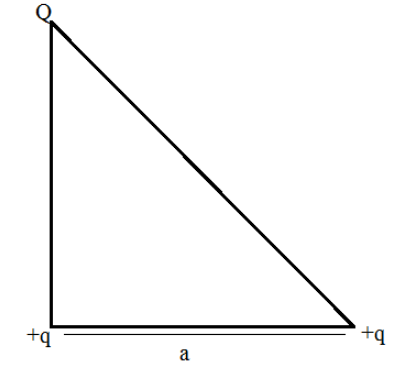Question
Question: Three charges Q, +q and +q are placed at the vertices of a right angled isosceles triangle as shown....
Three charges Q, +q and +q are placed at the vertices of a right angled isosceles triangle as shown. The net electronic energy of configuration is zero if Q is equal to:

(A) 1+2−q
(B) 1+2−q2
(C) −2q
(D) +q
Solution
In this question, we need to determine the value of the charge “Q” such that the net electronic energy of the configuration of the charges shown in the figure is equivalent to zero. For this, we will use Coulomb's law and substitute the given values in the coulomb’s formula. Write the formula for net potential (electrostatic) energy of the system and put it equal to zero.
Complete step by step answer:
Applying the Pythagoras theorem to determine the distance between the charges +Q and +q.
(dQq)=(dqq)2+(dqq)2
Substituting the values of the dqq as ‘a’ in the equation (dQq)=(dqq)2+(dqq)2 to determine the distance between the charges +Q and +q.
(dQq)=(dqq)2+(dqq)2 ⇒(dQq)=(a)2+(a)2 ⇒(dQq)=2a2 ⇒(dQq)=2a
Potential energy U=Krq1q2, where K = 4πε1.
Net potential energy of the system is given by U=KaQq+Kaqq+Ka2qQ
Given that net potential energy is 0. So,
U=0 ⇒KaQq+Kaqq+Ka2qQ=0
Now solve the equation for Q,
aKq(Q+q+2Q)=0 ⇒Q+2Q=−q ⇒2Q2+Q=−q ⇒Q(1+2)=−q2 ∴Q=(1+2)−q2
Hence, value of the charge “Q” such that the net electronic energy of the configuration of the charges shown in the figure is equivalent to zero is (1+2)−q2.
Hence,option B is correct.
Note: It is to be worth noting here that, the distance between the charges can be found by using the Pythagoras theorem as the charges are situated at the vertices of the isosceles triangles.
